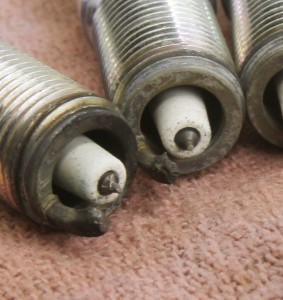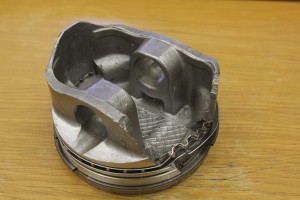Okay, I keep reading about there is a difference between detonation and pre-ignition but it seems that whenever I ask anybody about this, they agree but don’t know the difference. The typical answer I get is “It’s really complicated.” So, is it really?
J.M.
Jeff Smith: This really isn’t all that difficult to explain. Detonation is generally the result of any number of combinations of factors. First, let’s get into what happens when detonation occurs and then we can get into why it happens and then the difference between detonation and pre-ignition.
They are completely different but the end result can still be a wrecked engine.
This misunderstanding about detonation is not a new phenomenon. Frankly, the internal combustion engine is a very complex piece of machinery and when we start modifying it, it’s important to know quite a bit about how it works. I remember when I bought my first car, a ’66 389 GTO, and it would detonate or rattle occasionally. I asked an older friend who I thought knew about engines and he said “Oh, don’t worry about it.” I have since learned that he didn’t want to admit he didn’t know–but you should worry about it.
Let’s start with the combustion process. In school you may have been taught that when the spark plug lights off there’s a big bang and all the pressure from that explosion pushes the piston down. While it’s true there is cylinder pressure created by the expansion of the air and fuel mixture, but the “explosion” is really more like a fire burning across a pasture of dried grass. While measured in milliseconds, the combustion process starts in one area or corner of the combustion chamber and radiates outward from the spark plug. As the combustion process continues, the cylinder grows hotter as the pressure increases. Toward the end of the combustion, there are areas where the unburned fuel is now superheated along with the remaining oxygen. If the octane rating of the fuel is low enough, these end gases will tend to self-ignite, creating a pressure spike in the cylinder. This extreme pressure spike causes the piston to rattle within its bore, unseating the rings, and generally transferring severe impact loads into the connecting rod, through the upper rod bearing half and into the crankshaft. This impact is not unlike whacking the piston with a hammer.

That image should be enough to impress upon you that audible (there are also instances of inaudible, or trace detonation that you won’t hear) detonation is bad. Generally, forged pistons can withstand short periods of detonation as can some cast pistons. But cast pistons are much more brittle and depending upon the harshness of the detonation–damage can result. This is even worse with supercharged, turbocharged, or nitrous engines because the cylinder pressures are so much higher that the impact loads are that much greater compared to a normally aspirated engine. By now, the message should be clear that detonation is bad and should be avoided. One way you can tell if your engine has suffered detonation, even if you can’t hear it, is by looking at the spark plugs. After an engine has rattled, you will often see tiny black specs on the porcelain of the spark plug. I can’t explain why this happens, but it’s common enough so when you see those black specs, it’s time to make a tuning change either by removing a couple degrees of ignition timing or increasing the octane rating of the fuel, or both. Another relatively easy solution is to decrease the inlet air temperature. If you’ve ever wondered why an engine that is overheating will start detonating, that’s because the inlet air temperature is much greater in the combustion chamber because the cooling system has turned to steam and also because the overheated engine is heating the air going into the combustion chamber. The net result is detonation.
Pre-ignition is a completely different set of circumstances. You might be able to figure out the cause of this by its label. As we all know, the combustion process doesn’t start until the spark jumps across the electrode gap. But with pre-ignition, something glowing hot in the combustion space acts just like a spark plug and ignites the mixture. This is when bad things begin to happen. Often, this pre-ignition occurs with the piston far down in the bore and perhaps just after the intake valve closes. The rising piston is compressing the mixture but because combustion has already started, in a few milliseconds the pressure in the cylinder reaches astronomical levels and the piston has yet to achieve Top Dead Center (TDC). The end result is catastrophic piston and/or cylinder wall failure. The engine breaks immediately with no warning or indication that something has gone wrong.

Pre-ignition used to be a relatively rare occurrence but I think it has become far more prevalent in the last few years because engine power levels are steadily increasing. In my experience, much of the cause for pre-ignition is pretty simple–the improper spark plug choice. I’ve experienced this first-hand with a supercharged small-block Chevy that I was testing. It was a nicely built motor with hypereutectic pistons, a good flat tappet cam, and good heads. One of the last things I added was a set of extended tip spark plugs. These were cold heat range plugs, but the plug’s extended nose pushed it farther into the combustion chamber, which also means the ground strap was also longer. Unfortunately, when the engine started making really good power, this meant there was also more heat in the chamber. This additional heat also went into the ground strap. Because the strap is longer, it takes more time for the heat to transfer into the shell of the shell of the spark plug. Under a full power dyno pull after several previous runs rather close together, the engine suddenly lost power. We shut the engine down and discovered the spark plug ground electrode melted on several spark plugs. That wasn’t enough to have caused the dramatic power loss but the cylinder also was way down on cranking compression. The short version is that when we pulled the engine apart we discovered the piston had literally broken–along with a crack in the cylinder wall. This is what all the excess pressure does. Frankly, it should have been much worse.
The fix for that engine was to run not just a cold heat range plug, but to also use the shortest center electrode spark plug to keep the ground strap as short as possible. This shortens the heat path and should prevent any problems. About a year ago, Autolite introduced a new X-plug that is a surface gap spark plug with two grooves cut in the end of the shell, creating sharp points for the spark to jump while eliminating the ground strap altogether. I’ve run this plug in several supercharged and nitrous tests and the results have been very promising. Obviously, you no longer have the advantage of reading the heat on the ground strap for tuning purposes. But at least the engine won’t pre-ignite.
Hopefully this explanation clears up the very real differences between detonation and pre-ignition.
To wrap all this up, I used to spend a lot of time with the late John Lingenfelter at his shop in Decatur, IN. They guys in the shop listened to a rock radio station out of South Bend called The Bear. The station’s tag line used to be “103.9 – Detonation Rock!” I always thought it ironic standing next to one of John’s engines on the dyno listening to Detonation Rock when engine rattling was the last thing we wanted to hear.

Good article!
Wonderful article! Thank you!
Nice article
+919697717708
Moral: Don’t mess with factory settings.
Darryl Yates could tell all…not a ford fan here.
[…] Sound While Accelerating Could be pre-ignition or detonation. Here's a good article on it: Ask Away with Jeff Smith: What's the Difference Between Detonation and Pre-Ignition? – OnAllCylinder… Ever notice that there's so many high performance parts available for GM products? Did you […]
Good article. Can you please do an article on how to read the heat on the ground strap for tuning purposes?
“Engines don’t ‘detonate’ ! ‘Detonation’ requires either a phase change as part of the exothermic event or a diverging nozzle. Auto-ignition ahead of the flame front in SI (spark-ignition) engines is sonic, not supersonic. Therefore “detonation” is not the proper term. Either “auto-ignition” or “knock” are correct descriptors, knock referring to the audible sound emitted from sound waves traversing the combustion chamber at less than sonic velocity.”
Engines don’t “pre-ignite”. Engineers can see what’s actually happening inside the engine with pressure transducers. What even some engineers call “pre-ignition” still has the pressure spike ATDC.